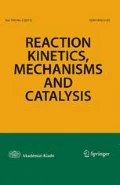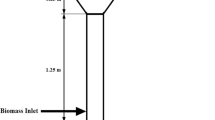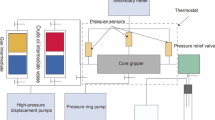Abstract
The effects of various factors on the hydrodegumming (HDG) of oil during the deep hydrogenation of coal-based aerospace kerosenee (CBAK) were studied by single factor experiment and response surface methodology (RSM) analysis on a fixed-bed hydrogenation unit with the existent gum content as the observation value. The results show that in order to achieve better HDG effect of CBAK, it must be carried out at high reaction temperature (T), high reaction pressure (P) and low liquid hourly space velocity (LHSV). The influence of various factors on the gum content of hydrogenated oil was analyzed by using the Design Expert software. The influence degree order was as follows: LHSV > P > T. At the same time, the process conditions of deep hydrogenation were optimized by simulation: P = 11.91 MPa, LHSV = 1.60 h−1, V(H2)/V(Oil) = 800, T = 619.84 K, under which the expected gum content was 0.26 mg (100 mL)−1. On this basis, according to the speed of CBAK-HDG reactivity, the existent gum in the raw material were divided into three lumps, which are high reactivity, medium reactivity, and slow reactivity, then the three lumped kinetic model of CBAK-HDG was established. The kinetic parameters of the model were calculated by Levenberg–Marquardt method, and the model was verified by the measured data. The experimental results show that the average relative error of the model is 8.28%, the predicted value is reliable and the extrapolation is quite good. The calculation results of the model parameters correspond to the results of RSM, which is consistent with the hydrogenation reaction law. The results of this study are expected to provide some theoretical basis and reference for the further study of coal-based space kerosene hydrofining process and the optimization of operation conditions of industrial units.









Similar content being viewed by others
Abbreviations
- CBAK:
-
Coal-based aerospace kerosene
- HDG:
-
Hydrodegumming
- RSM:
-
Response surface methodology
- T :
-
Reaction temperature (K)
- P :
-
Reaction pressure (MPa)
- LHSV :
-
Liquid hourly space velocity (h−1)
- V(H2)/V(Oil):
-
Volume ratio of hydrogen-oil
- t :
-
Reaction time (h)
- x i :
-
The ratio of lump-i gum content to total gum content in the feedstock (%)
- k i0 :
-
Pre-exponential factor of Arrhenius equation of lump-i (h−1)
- k i :
-
Apparent reaction rate constant of lump-i
- w 0 :
-
Gum content in feed (mg (100 mL)−1)
- w G :
-
Gum content in product (mg (100 mL)−1)
- w i 0 :
-
Gum content of lump-i in feed (mg (100 mL)−1)
- w i :
-
Gum content of lump-i in product (mg (100 mL)−1)
- E i :
-
Activation energy of lump-i (kJ mol−1)
- a i :
-
Correction factor for reaction pressure of lump-i
- b i :
-
Correction factor for reaction time of lump-i
- n :
-
Number of experiments
- R :
-
Universal gas constant (kJ mol−1 K−1)
- \(\overline{{E_{r} }}\) :
-
The average relative error (%)
- SSR:
-
Sum of Squares due to residuals
- \(w^{{{\text{Cal}}}}\) :
-
Calculated gum content of experimental sample i (mg (100 mL)−1)
- \(w^{{{\text{Exp}}}}\) :
-
Experimental gum content of experimental sample i (mg (100 mL)−1)
- \(y_{{{\text{HDG}}}}^{i}\) :
-
The removal rate of gum after hydrodegumming of lump-i (%)
References
Tang HQ (2010) Status and development of coal to oil technique in China. Chem Eng 38:1–8
Schulz H (1999) Short history and present trends of Fischer-Tropsch synthesis. Appl Catal A 186:3–12
Chung HS, Chen CSH, Kremer RA (1999) Recent developments in high-energy density liquid hydrocarbon fuels. Energy Fuels 13:641–649
Maurice L, Edwards T (2000) Liquid hydrocarbon fuels for hypersonic propulsion. Prog Astronaut Aeronaut 189:757–775
Edwards T (1996) Recent research results in advanced fuels. ACS DIV Pet Chem 41:481–487
Zhang DM, Zhang HA, Cao WJ (2008) Effects of the heat stability of the jet fuel on the aeroengine. Aeronaut Manufact Technol 13:91–93
He F, Mi ZT, Sun HY (2006) Improvement of heat sink of endothermic hydrocarbon fuels. Prog Chem 18:1041–1048
Guo RQ, Tang ZF, Shang ST (2016) Simulation on influence of alternative fuel on combustor performance for aeroengine. Aeroengine 42:21–24
Yh LI, Paul W, Patricio H (2007) Formation of gum and deposits in an oxygenated naphtha stream. Heat Exch Fouling Clean 5:80–89
Florian P, Sergio L, Ana R (2015) Gum formation in gasoline and its blends:a review. Energy Fuels 29:7753–7770
Dai M, Niu SK, Li SC (2018) Evaluation of reducing existing gum in 2nd atmospheric side-stream by hydrogenation process. Petrol Refin Eng 48:14–16
National military standard of the People’s Republic of China (2013) Kerosene safe application rules for liquid rocket engine (GJB 8087-2013)
Xu HY (1999) Discussion on the factors affecting the determination of the actual gum in engine fuel. J Xinjiang Educ Inst 3:50–51
Antipenko VR, Grin’ko AA, Melenevskii VN (2014) Composition of products of analytical pyrolysis of resin and asphaltene fractions of Usa oil. Petrol Chem 54:178–186
Grinko AA, Golovko AK (2011) Fractionation of resins and asphaltenes and investigation of their composition and structure using heavy oil from the Usa field as an example. Petrol Chem 51:192–202
Li T, Xu J, Zou R (2018) Resin from liaohe heavy oil: molecular structure, aggregation behavior and effect on oil viscosity. Energy Fuels 32:306–313
Cheshkova TV, Sergun VP, Kovalenko EY (2019) Resins and asphaltenes of light and heavy oils: their composition and structure. Energy Fuels 33:7971–7982
Xu ZX, Xu H (2003) A discussion on trial-produce military diese oil hydrotreating refining condition. Petrol Prod Appl Res 6:24–27
Yu HT (2002) Pilot plant test for preparing -10# military diesel oil. Petrol Process Petrochem 12:31–34
Yang CG (2007) Study on OTA technology for FCC gasoline upgrading and determination of existent gum. Dalian University of Technology
Fang XC (2006) Hydrorefining (In Chinese). China Pedrochemical Press Co., Ltd
Li CN (2002) Residue processing technology (In Chinese). China Pedrochemical Press Co. Ltd
Katzer JR (1979) Process and catalyst needs for hydrodenitrogenation. Catal Rev 20:155–208
Allen DT, Grandy DW, Jeong KM (1985) Heavier fractions of shale oils, heavy crudes, tar sands, and coal liquids: comparison of structural profiles. Ind Eng Chem Process Des Dev 24:737–742
Yu H, Zhao JG, Hou XM (2014) Study on hydrogenation of unsaturated hydrocarbon during FCC gasoline desulfurization by S-Zorb process. Petrol Process Petrochem 45:14–19
Liu TB (2017) Commercial application of new generation FZC residue hydrotreating catalysts. Ind Catal 25:53–56
Xu HS, Zhong F, Xu SY (2017) Progress in presulfurization technology of hydrogenation catalyst. Petrochem Technol Appl 35:238–242
National Standard of the People’s Republic of China (1987) Motor gasoline and aviation fuels- Determination of existent gum- Jet evaporation method (GB/T 8019-1987)
Shi BK (2011) Effect of reaction pressure on hydrogenation process. China New Technol Prod 9:2–3
Li D, Li WH, Gao X (2010) Optimization for hydrodenitrification process of coal tar using response surface methodology. Chem Ind Eng Prog 29:634–637
Guisnet M, Magnoux P (2001) Organic chemistry of coke formation. Appl Catal A 212:83–96
Yu FG, Zhang JT (2017) Optimization of hydrotreating process conditions by using Ni-Mo/γ-Al2O3 catalyst. Contemp Chem Ind 46:24–27
Sun YD, Yang ZH, Gu ZJ (2013) Influence of reaction temperature on the content and structure of four fractions in residue hydrotreating. J Fuel Chem Technol 41:309–313
Li L, Zhang S, He Q (2015) Application of response surface methodology in experiment design and optimization. Res Explor Lab 34:41–45
Li D, Li WH, Liu QC (2015) Optimization of processing parameters and macrokinetics for hydrodesulfurization of coal tar. Energy Sour Part A 37:2591–2600
Fang X, Fang XC, Cheng ZM (2005) Reaction kinetics of diesel deep hydrodesulfurization. Contemp Chem Ind 34:145–148
Ma CG, Weng HX (2008) Prior simulation of lumping kinetic models for residual oil HDS reaction. Acta Petrol Sin (Petrol Process Sect) 24:709–713
Tang X, Li SY, Yue CT (2015) Lumping kinetic models of shale oil hydrodenitrogenation. Acta Petrol Sin (Petrol Process Sect) 31:1354–1362
Yu H, Jin GZ, Li SY (2011) Kinetics of hydrodesulfurization of diesel distillate from Fushun shale oil. Acta Petrol Sin (Petrol Process Sect) 27:924–928
Bai R, Zhang CF, Chai YM (2012) Study on the process conditions and kinetic of slurry-bed hydrogenation processing vacuum gas oil. Petrol Process Petrochem 43:66–70
Zhu YH, Zhang YH, Dan Y (2015) Optimization of reaction variables and macrokinetics for the hydrodeoxygenation of full range low temperature coal tar. Reac Kinet Mech Cat 116:433–450
Sun JM, Li D, Yao RQ (2015) Modeling the hydrotreatment of full range medium temperature coal tar by using a lumping kinetic approach. Reac Kinet Mech Cat 114:451–471
Acknowledgements
The financial supports of this work are provided by the National Natural Science Foundation of China (21978237), Key Research and Development Program of Shaanxi (Program No. 2018ZDXM-GY-161), The Technology Innovation Leading Program of Shaanxi (Program No. 2019CGHJ-11), the Key Scientific Research Plan (Key Laboratory)of Shaanxi Provincial Department of Education(Program No. 17JS146), Science and technology plan of Xi'an aerospace special chemical material engineering technology research center (Program No. 165MEC2019-01).
Author information
Authors and Affiliations
Corresponding author
Additional information
Publisher's Note
Springer Nature remains neutral with regard to jurisdictional claims in published maps and institutional affiliations.
Electronic supplementary material
Below is the link to the electronic supplementary material.
Rights and permissions
About this article
Cite this article
Tian, F., Zhu, Y., Liu, J. et al. Optimization and lumped kinetic model study of coal-based aerospace kerosene hydrogenation process. Reac Kinet Mech Cat 130, 753–775 (2020). https://doi.org/10.1007/s11144-020-01813-9
Received:
Accepted:
Published:
Issue Date:
DOI: https://doi.org/10.1007/s11144-020-01813-9




